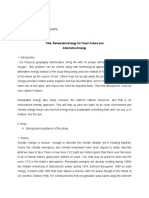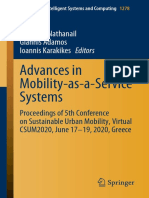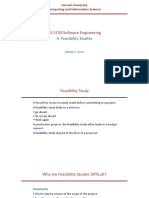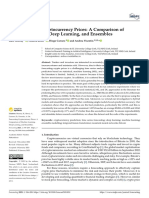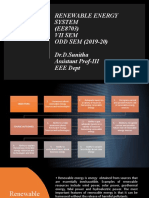Certificate: Kartik Pandya Paresh Modha Hod
Certificate: Kartik Pandya Paresh Modha Hod
Uploaded by
Samyak ShahCopyright:
Available Formats
Certificate: Kartik Pandya Paresh Modha Hod
Certificate: Kartik Pandya Paresh Modha Hod
Uploaded by
Samyak ShahOriginal Title
Copyright
Available Formats
Share this document
Did you find this document useful?
Is this content inappropriate?
Copyright:
Available Formats
Certificate: Kartik Pandya Paresh Modha Hod
Certificate: Kartik Pandya Paresh Modha Hod
Uploaded by
Samyak ShahCopyright:
Available Formats
09EE002
Solar Power Energy
CERTIFICATE
This is to certify that the project entitled Solar Power Energy is a bonafide report of the work carried out by Mr. Samyak Shah (09EE002) under the guidance and supervision for the award of the degree of Bachelor of Electrical Engineering at Charotar Institute of Science & Technology (CHARUSAT) Changa, Gujarat To the best of my knowledge and belief, this work embodies the work of candidate himself, has duly been completed, fulfills the requirement of the ordinance relating to the Bachelor degree of the university and is up to the standard in respect of content, presentation and language for being referred to the examiner.
DATE: ____________
Kartik Pandya HOD,
M&V Patel Department of Electrical Engineering C.S.P.I.T CHARUSAT
Paresh Modha
M&V Patel Department of Electrical Engineering, C.S.P.I.T CHARUSAT
Page 1
09EE002
Solar Power Energy
Acknowledgement
I have taken efforts in this project. However, it would not have been possible without the kind support and help of many individuals. I would like to extend my sincere thanks to all of them.
I am highly indebted to Mr. Paresh Modha for his guidance and constant supervision as well as for providing necessary information regarding the project & also for their support in completing the project. I would like to express my gratitude towards my parents & members of CHARUSAT for their kind co-operation and encouragement which helped me in the completion of this project.
My thanks and appreciations also go to my colleagues in developing the project and people who have willingly helped me out with their abilities.
Page 2
09EE002
Solar Power Energy
SOLAR POWER ENERGY By: Samyak S. Shah 09EE002
In charge Faculty: Paresh Modha
M & V Patel Department of Electrical Engineering
Page 3
09EE002
Solar Power Energy
Page 4
09EE002
Solar Power Energy
I. INTRODUCTION Mirror mirror on the wall, what's the greatest energy source of all? The sun. Enough energy from the sun falls on the Earth everyday to power our homes and businesses for almost 30 years. Yet we've only just begun to tap its potential. You may have heard about solar electric power to light homes or solar thermal power used to heat water, but did you know there is such a thing as solar thermal-electric power? Electric utility companies are using mirrors to concentrate heat from the sun to produce environmentally friendly electricity for cities, especially in the southwestern United States. The southwestern United States is focusing on concentrating solar energy because it's one of the world's best areas for sunlight. The Southwest receives up to twice the sunlight as other regions in the country. This abundance of solar energy makes concentrating solar power plants an attractive alternative to traditional power plants, which burn polluting fossil fuels such as oil and coal. Fossil fuels also must be continually purchased and refined to use. Unlike traditional power plants, concentrating solar power systems provide an environmentally benign source of energy, produce virtually no emissions, and consume no fuel other than sunlight. About the only impact concentrating solar power plants have on the environment is land use. Although the amount of land a concentrating solar power plant occupies is larger than that of a fossil fuel plant, both types of plants use about the same amount of land because fossil fuel plants use additional land for mining and exploration as well as road building to reach the mines. Other benefits of concentrating solar power plants include low operating costs, and the ability to produce power during high-demand energy periods and to help increase our energy securityour country's independence
Page 5
09EE002
Solar Power Energy
from foreign oil imports. There are three solar thermal power systems currently being developed by U.S. industry: parabolic troughs, power towers, and dish/engine systems. Because these technologies involve a thermal intermediary, they can be readily hybridized with fossil fuel and in some cases adapted to utilize thermal storage. The primary advantage of hybridization and thermal storage is that the technologies can provide dispatchable power and operate during periods when solar energy is not available. Hybridization and thermal storage can enhance the economic value of the electricity produced and reduce its average cost. This paper provides an introduction on each of the three technologies, an overview of the technologies, their current status
Page 6
09EE002
Solar Power Energy
II. WHY CONCENTRATING SOLAR POWER? Economic Sustainability: The history of the Solar Electricity Generating Systems (SEGS) shows impressive cost reductions achieved up to now. Advanced technologies, mass production, economies of scale and improved operation will allow to reduce the solar electricity cost to a competitive level within the next 10 to 15 years. This will reduce the dependency on fossil fuels and thus, the risk of future electricity cost escalation. Hybrid solar-and-fuel plants, at favorable sites, making use of special schemes of finance, can already deliver competitively priced electricity today. Environmental Sustainability: Life cycle assessment of emissions (bottom) and of land surface impacts of the concentrating solar power systems shows that they are best suited for the reduction of greenhouse gases and other pollutants, without creating other environmental risks or contamination. Most of the collector materials can be recycled and used again for further plants. Social Sustainability: Their integration into the grid does not require any measures for stabilization or backup capacity. On the contrary, they can be used for these purposes, allowing for a smooth transition from todays fossil fuel based power schemes to a future renewable energy economy. In sun-belt countries, CSP will reduce the consumption of fossil energy resources and the need for energy imports. The power supply will be diversified with a resource that is distributed in a fair way and accessible by many countries. Process heat from combined generation can be used for seawater desalination and help, together with a more rational use of water, to address the challenge of growing water scarcity in many arid regions. Thus, CSP will not only create
Page 7
09EE002
Solar Power Energy
thousands of jobs and boost economy, but will also effectively reduce the risks of conflicts related to energy, water and climate change.
III. TECHNOLOGY OVERVIEW Unlike solar (photovoltaic) cells, which use light to produce electricity, concentrating solar power systems generate electricity with heat. Concentrating solar collectors use mirrors and lenses using various mirror configurations to concentrate and focus sunlight onto a thermal receiver, similar to a boiler tube. The receiver absorbs and converts sunlight into heat. The heat is then transported to a steam generator or engine where it is converted into electricity. The heat is then channeled through a conventional generator. The plants consist of two parts: one that collects solar energy and converts it to heat, and another that converts heat energy to electricity. There are three main types of concentrating solar power systems: parabolic troughs, dish/engine systems, and central receiver systems. These technologies can be used to generate electricity for a variety of applications, ranging from remote power systems as small as a few kilowatts (kW) up to grid-connected applications of 200-350 megawatts (MW) or more. That is concentrating solar power systems can be sized for village power (10 kilowatts) or grid-connected applications. Some systems use thermal storage during cloudy periods or at night. Others can be combined with natural gas and the resulting hybrid power plants provide high-value, dispatchable power. The amount of power generated by a concentrating solar power plant depends on the amount of direct sunlight. Like concentrating photovoltaic concentrators, these technologies use only direct-beam sunlight, rather than diffuse solar radiation.
Page 8
09EE002
Solar Power Energy
IV. SOLAR PARABOLIC TROUGH
Fig 1: Solar parabolic trough system schematic diagram
The collector field consists of a large field of single-axis tracking parabolic trough solar collectors. The solar field is modular in nature and is composed of many parallel rows of solar collectors aligned on a north-south horizontal axis. Each solar collector has a linear parabolic-shaped reflector that focuses the suns direct beam
Page 9
09EE002
Solar Power Energy
radiation on a linear receiver located at the focus of the parabola. The collectors track the sun from east to west during the day to ensure that the sun is continuously focused on the linear receiver. A heat transfer fluid (HTF) is heated as it circulates through the receiver and returns to a series of heat exchangers in the power block where the fluid is used to generate high-pressure superheated steam. The superheated steam is then fed to a conventional reheat steam turbine/generator to produce electricity. The spent steam from the turbine is condensed in a standard condenser and returned to the heat exchangers via condensate and feed-water pumps to be transformed back into steam. Condenser cooling is provided by mechanical draft wet cooling towers. After passing through the HTF side of the solar heat exchangers, the cooled HTF is re-circulated through the solar field. Individual trough systems currently can generate about 80 megawatts of electricity. Trough designs can incorporate thermal storagesetting aside the heat transfer fluid in its hot phase allowing for electricity generation several hours into the evening. Currently, all parabolic trough plants are "hybrids," meaning they use fossil fuel to supplement the solar output during periods of low solar radiation.
Fig 2: Solar Trough
Page 10
09EE002
Solar Power Energy
IV.a System Application, Benefits, and Impacts Large-scale Grid Connected Power: The primary application for parabolic trough power plants is large-scale grid connected power applications in the 30 to 300 MW range. Because the technology can be easily hybridized with fossil fuels, the plants can be designed to provide firm peaking to intermediate load power. Domestic Market: The primary domestic market opportunity for parabolic trough plants is in the areas where the best direct normal solar resources exist. However, other nearby places may provide excellent opportunities as well. With utility restructuring, and an increased focus on global warming and other environmental issues, many new opportunities such as renewable portfolio standards and the development of solar enterprise zones may encourage the development of new trough plants. International Markets: With the high demand for new power generation in many developing countries, the next deployment of parabolic troughs could be in any arid regions in developing countries as they are ideally suited for parabolic trough technologies. India, Egypt, Morocco, Mexico, Brazil, Crete (Greece), and Tibet (China) have expressed interest in trough technology power plants. Many of these countries are already planning installations of combined cycle projects.
Page 11
09EE002
Solar Power Energy
IV.b. Benefits Least Cost Solar Generated Electricity: Trough plants currently provide the lowest cost source of solar generated electricity available. They are backed by considerable valuable operating experience. Troughs will likely continue to be the least-cost solar option for another 5-10 years depending on the rate of development and acceptance of other solar technologies. Daytime Peaking Power: Parabolic trough power plants have a proven track record for providing firm renewable daytime peaking generation. Trough plants generate their peak output during sunny periods when air conditioning loads are at their peak. Integrated natural gas hybridization and thermal storage have allowed the plants to provide firm power even during non-solar and cloudy periods. Environmental: Trough plants reduce operation of higher-cost, cycling fossil generation that would be needed to meet peak power demands during sunny afternoons at times when the most photochemical smog, which is aggravated by NO emissions from power plants, is produced. Economic: The construction and operation of trough plants typically have a positive impact on the local economy. A large portion of material during construction can generally be supplied locally. Also trough plants tend to be fairly labor-intensive during both construction and operation, and much of this labor can generally be drawn from local labor markets.
Page 12
09EE002
Solar Power Energy
V. POWER TOWER SYSTEMS
Fig 3: Molten-salt power tower system schematic
Solar power towers generate electric power from sunlight by focusing concentrated solar radiation on a towermounted heat exchanger (receiver). The system uses hundreds to thousands of sun-tracking mirrors called heliostats to reflect the incident sunlight onto the receiver. These plants are best suited for utility-scale applications in the 30 to 400 MWe range. In a molten-salt solar power tower, liquid salt at 290C (554F) is pumped from a cold storage tank through the receiver where it is heated to 565C (1,049F) and then on to a
Page 13
09EE002
Solar Power Energy
hot tank for storage. When power is needed from the plant, hot salt is pumped to a steam generating system that produces superheated steam for a conventional Rankine cycle turbine/generator system. From the steam generator, the salt is returned to the cold tank where it is stored and eventually reheated in the receiver. Figure 3 is a schematic diagram of the primary flow paths in a molten-salt solar power plant. Determining the optimum storage size to meet power-dispatch requirements is an important part of the system design process. Storage tanks can be designed with sufficient capacity to power a turbine at full output for up to 13 hours. The heliostat field that surrounds the tower is laid out to optimize the annual performance of the plant. The field and the receiver are also sized depending on the needs of the utility. In a typical installation, solar energy collection occurs at a rate that exceeds the maximum required to provide steam to the turbine. Consequently, the thermal storage system can be charged at the same time that the plant is producing power at full capacity. The ratio of the thermal power provided by the collector system (the heliostat field and receiver) to the peak thermal power required by the turbine generator is called the solar multiple. Power towers must be large to be economical. Power tower plants are not modular and can not be built in the smaller sizes of dish/stirling or trough-electric plants and be economically competitive, but they do use a conventional power block and can easily dispatch power when storage is available.
Fig 4: Power tower system
Page 14
09EE002
Solar Power Energy
V.a System Application, Benefits, and Impacts As the technology matures, plants with up to a 400 MW rating appear feasible. As non-polluting energy sources become more favored, molten-salt power towers will have a high value because the thermal energy storage allows the plant to be dispatchable. Consequently, the value of power is worth more because a power tower plant can deliver energy during peak load times when it is more valuable. Energy storage also allows power tower plants to be designed and built with a range of annual capacity factors (20 to 65%). Combining high capacity factors and the fact that energy storage will allow power to be brought onto the grid in a controlled manner (i.e., by reducing electrical transients thus increasing the stability of the overall utility grid); total market penetration should be much higher than an intermittent solar technology without storage. One possible concern with the technology is the relatively high amount of land and water usage. This may become an important issue from a practical and environmental viewpoint since these plants are typically deployed within desert areas that often lack water and have fragile landscapes. Water usage at power towers is comparable to other Rankine cycle power technologies of similar size and annual performance. Land usage, although significant, is typically much less than that required for hydro and is generally less than that required for fossil (e.g., oil, coal, natural gas), when the mining and exploration of land are included.
Page 15
09EE002
Solar Power Energy
VI. DISH/ENGINE SYSTEMS
Fig 5: Dish/engine system schematic.
Dish/engine systems convert the thermal energy in solar radiation to mechanical energy and then to electrical energy in much the same way that conventional power plants convert thermal energy from combustion of a fossil fuel to electricity. Figure 5 indicates dish/engine systems uses a mirror array to reflect and concentrate incoming direct normal insulation to a receiver, in order to achieve the temperatures required to efficiently convert heat to work. This requires that the dish track the sun in two axes. The concentrated solar radiation is absorbed by the receiver and transferred to an engine. Dish/engine systems are characterized by high efficiency, modularity, autonomous operation, and an inherent hybrid capability (the ability to operate on
Page 16
09EE002
Solar Power Energy
either solar energy or a fossil fuel, or both). Of all solar technologies, dish/engine systems have demonstrated the highest solar-to-electric conversion efficiency , and therefore have the potential to become one of the least expensive sources of renewable energy. The modularity of dish/engine systems allows them to be deployed individually for remote applications, or grouped together for small-grid (village power) or end-of-line utility applications. Dish/engine systems can also be hybridized with a fossil fuel to provide dispatchable power. This technology is in the engineering development stage and technical challenges remain concerning the solar components and the commercial availability of a solarizable engine.
Fig 5: Dish/Engine System
Page 17
09EE002
Solar Power Energy
VI.a System Application, Benefits, and Impacts Solar dish/engine systems have environmental, operational, and potential economic advantages over more conventional power generation options because they: Produce zero emissions when operating on solar energy; Operate more quietly than diesel or gasoline engines; Are easier to operate and maintain than conventional engines; Start up and shut down automatically; Operate for long periods with minimal maintenance; Because dish/engine systems use heat engines, they have an inherent ability to operate on fossil fuels; Dish/engine systems can also be used individually as stand-alone systems; Because of their versatility and hybrid capability, dish/engine systems are capable of providing power ranging from kilowatts to gigawatts. Largely because of their high efficiency, the cost of these systems is expected to be lower than that of other solar systems for these applications. The market timing for solar dish/engine technology is promising, both at home and abroad. Cleaner, simpler, and more versatile than conventional diesel or gasoline engines, solar dish/engine systems will help open up nontraditional markets for electricity to serve these people.
Page 18
09EE002
Solar Power Energy
VII. CONCLUSION Solar technology has made huge technological and cost improvements, but more research and development remains to be done to make it cost-competitive with fossil fuels. Costs can be reduced by increasing demand for this technology worldwide, as well as through improved component design and advanced systems. Concentrating solar power technologies currently offer the lowest-cost solar electricity for large-scale power generation (10 MW-electric and above). New innovative hybrid systems that combine large concentrating solar power plants with conventional natural gas combined cycle or coal plants can further reduce costs. Advancements in the technology and the use of low-cost thermal storage will allow future concentrating solar power plants to operate for more hours during the day and shift solar power generation to evening hours. Researchers are developing lower cost solar concentrators, high-efficiency engine/generators, and highperformance receivers. The goal is to further develop the technology to increase acceptance of the systems and help the systems penetrate growing domestic and international energy markets. Developing countries in Asia, Africa, and Latin Americawhere half the population is currently without electricity and sunlight is usually abundantrepresent the biggest and fastest growing market for power producing technologies. One key competitive advantage of concentrating solar energy systems is their close resemblance to most power plants. Concentrating solar power technologies use many of the same technologies and equipment used by conventional power plants; they simply substitute the concentrating power of the sun for the combustion of fossil fuels to provide the energy for conversion into electricity. Estimates have predicted that by 2005, there will be as much as 500 MW of concentrating solar power capacity installed worldwide. By 2020, more than 20 gigawatts of concentrating solar power systems could be installed throughout the world. Such a situation translates to a cleaner and reliable power in the third world countries.
Page 19
09EE002
Solar Power Energy
VIII. REFERENCES www.eren.doe.gov/sunlab
www.eren.doe.gov/power/success_stories/pdfs/solar_troughs.pdf.
www.eren.doe.gov/power/success_stories/pdfs/power_tower.pdf
Mancini, T., G.J. Kolb, and M. Prairie, Solar Thermal Power
Page 20
You might also like
- 1203-Article Text-4405-1-10-20210630 PDFDocument6 pages1203-Article Text-4405-1-10-20210630 PDFKha NguyenNo ratings yet
- QF ProjectDocument27 pagesQF Projectmhod omranNo ratings yet
- Economics of CAT 3516A+ Versus CAT 3520 EnginesDocument14 pagesEconomics of CAT 3516A+ Versus CAT 3520 EnginesWolf KhanNo ratings yet
- Industrial Training Presentation: PETRONAS Chemicals Methanol Labuan Sdn. BHDDocument9 pagesIndustrial Training Presentation: PETRONAS Chemicals Methanol Labuan Sdn. BHDAbdul AzizNo ratings yet
- Star Health Assure One Pager Version 10 April 202 221117 113317Document4 pagesStar Health Assure One Pager Version 10 April 202 221117 113317ApnerNo ratings yet
- Star Health Assure - One Pager - Version 1.0 - April - 2022Document2 pagesStar Health Assure - One Pager - Version 1.0 - April - 2022Rohit kanyal0% (1)
- TDS of Top CoatDocument7 pagesTDS of Top Coatedm 60yNo ratings yet
- Renewable Energy For Clean Future and Alternative EnergyDocument5 pagesRenewable Energy For Clean Future and Alternative EnergyAyeshia Kelly MesinaNo ratings yet
- Annex 1 - Feasibility StudyDocument186 pagesAnnex 1 - Feasibility Studynicu_boevicuNo ratings yet
- Solar Energy in India, Strategies Policies PerspectivesDocument9 pagesSolar Energy in India, Strategies Policies PerspectivesMaaz AhmadNo ratings yet
- Soal Uas B.ingg - BDocument15 pagesSoal Uas B.ingg - BWin DaNo ratings yet
- Dii Battery Storage Report December 2019Document40 pagesDii Battery Storage Report December 2019Trainer 01No ratings yet
- Corolla EbrochureDocument24 pagesCorolla Ebrochurerobin5362No ratings yet
- NYC Energy Water Use 2013 ReportDocument64 pagesNYC Energy Water Use 2013 Reportcrainsnewyork100% (1)
- Superconducting Wire Market - Segmentation Detailed Study With Forecast - Facts and TrendsDocument2 pagesSuperconducting Wire Market - Segmentation Detailed Study With Forecast - Facts and Trendssurendra choudharyNo ratings yet
- Microwave Sintering-XDocument10 pagesMicrowave Sintering-XKshitij RautNo ratings yet
- Internship Report 4Document57 pagesInternship Report 4Nasir SaedNo ratings yet
- Solar Energy Lecture NotesDocument16 pagesSolar Energy Lecture NotesJignesh GadhwalNo ratings yet
- Akac 2021Document1,157 pagesAkac 2021J MNo ratings yet
- A Study On Investment Analysis in Commodity Market With Special Reference To Multi Commodity Exchange Project ReportDocument6 pagesA Study On Investment Analysis in Commodity Market With Special Reference To Multi Commodity Exchange Project ReportNavneet SinghNo ratings yet
- Rural Electrification and Expansion Planning of Off-Grid MicrogridsDocument7 pagesRural Electrification and Expansion Planning of Off-Grid MicrogridsRafael SardinhaNo ratings yet
- Smaller Safer Fairer: A Roadmap To Closing Rikers IslandDocument53 pagesSmaller Safer Fairer: A Roadmap To Closing Rikers Islandcrainsnewyork100% (1)
- Direct Hydrogen Fuel Cell Electric Vehicle Cost AnalysisDocument10 pagesDirect Hydrogen Fuel Cell Electric Vehicle Cost AnalysisANo ratings yet
- Overview of Plug-In Electric Vehicle Technologies: K.Ramalingam and C.S.IndulkarDocument21 pagesOverview of Plug-In Electric Vehicle Technologies: K.Ramalingam and C.S.Indulkarpratap68No ratings yet
- Mca 405 BDocument2 pagesMca 405 Bkola0123No ratings yet
- UntitledDocument1 pageUntitledTariku TemesgenNo ratings yet
- Roadmapping Coal's Future: Zero Emissions Technologies For Fossil FuelsDocument22 pagesRoadmapping Coal's Future: Zero Emissions Technologies For Fossil FuelsMunawar HussainNo ratings yet
- Strategic Management Final Report 2Document31 pagesStrategic Management Final Report 2Ekta IoBMNo ratings yet
- 4 Feasibility PDFDocument27 pages4 Feasibility PDFMuneeb ur rehman ansariNo ratings yet
- 117-Load Cases For MKS Tower TestingDocument2 pages117-Load Cases For MKS Tower Testingnarinder100% (1)
- Overcurrent ProtectionDocument23 pagesOvercurrent ProtectiondaodoquangNo ratings yet
- Group 2 Project ReportDocument70 pagesGroup 2 Project ReportBijaya RaulaNo ratings yet
- Electrical Project1234Document35 pagesElectrical Project1234Sahil SinghNo ratings yet
- EE Mach 323 NewDocument14 pagesEE Mach 323 NewBryan Rivera SumagaysayNo ratings yet
- Sources of LawDocument14 pagesSources of LawAlya Syaffa100% (1)
- System Design and Realization of A Solar-Powered Electric Vehicle Charging StationDocument12 pagesSystem Design and Realization of A Solar-Powered Electric Vehicle Charging StationankitabhuNo ratings yet
- 3 Electrical Power SupplyDocument17 pages3 Electrical Power SupplyCOLLINS KIPRUTONo ratings yet
- 2021 - Significance of Sensors For Industry 4.0Document12 pages2021 - Significance of Sensors For Industry 4.0deepakNo ratings yet
- Feasibility Study GuidelinesDocument35 pagesFeasibility Study GuidelinesMaulidiBarasaNo ratings yet
- On Forecasting Cryptocurrency Prices - A Comparison of Machine Learning, Deep Learning and EnsemblesDocument14 pagesOn Forecasting Cryptocurrency Prices - A Comparison of Machine Learning, Deep Learning and Ensemblesmarcmyomyint1663No ratings yet
- Journal of Cleaner Production: Li-Yin Shen, Vivian W.Y. Tam, Leona Tam, Ying-Bo JiDocument6 pagesJournal of Cleaner Production: Li-Yin Shen, Vivian W.Y. Tam, Leona Tam, Ying-Bo JiNhan DoNo ratings yet
- The C2M2: Helping Utilities With Cybersecurity PreparednessDocument29 pagesThe C2M2: Helping Utilities With Cybersecurity Preparednessjesus_yustasNo ratings yet
- Storage Bulletin Jul'19Document5 pagesStorage Bulletin Jul'19sanjeevpnd4390% (1)
- RFP Document For AEDocument262 pagesRFP Document For AEDattaNo ratings yet
- Study of Different Type of Solar CellDocument4 pagesStudy of Different Type of Solar CellInternational Journal of Innovative Science and Research TechnologyNo ratings yet
- R188819Q Intern ReportDocument28 pagesR188819Q Intern ReportTinashe TararaNo ratings yet
- Energy NTWG Report Vision 202020Document179 pagesEnergy NTWG Report Vision 202020Mukhtar OyewoNo ratings yet
- Nanocraft - An Aircraft WithDocument6 pagesNanocraft - An Aircraft WithiaetsdiaetsdNo ratings yet
- Strategic Aspects of The Anglo-German Naval Race: Paul KennedyDocument35 pagesStrategic Aspects of The Anglo-German Naval Race: Paul KennedyDee NayNo ratings yet
- A Critical Review and Analysis On Energy Storage Systems Applicable in Micro GridsDocument7 pagesA Critical Review and Analysis On Energy Storage Systems Applicable in Micro GridsIJRASETPublicationsNo ratings yet
- Wolkite University: Senior ProjectDocument42 pagesWolkite University: Senior ProjectOlyad JemalNo ratings yet
- A Critical Review of Comparative Global Historical Energy Consumption and Future Demand The Story Told So FarDocument19 pagesA Critical Review of Comparative Global Historical Energy Consumption and Future Demand The Story Told So FarCharina Anggraeni100% (1)
- A Study of The Effect of Design Parameters On The Performance of Linear Solar Concentrator Based Thermal Power Plants in IndiaDocument10 pagesA Study of The Effect of Design Parameters On The Performance of Linear Solar Concentrator Based Thermal Power Plants in IndiaOscar Rojas ValenciaNo ratings yet
- SPR2022-14-103122 - 799 Indian Church RoadDocument3 pagesSPR2022-14-103122 - 799 Indian Church RoadDaniel T. WarrenNo ratings yet
- 33 Industry Research ReportDocument97 pages33 Industry Research Reportfaleela IsmailNo ratings yet
- Machine Old QuesDocument30 pagesMachine Old QuesbibekNo ratings yet
- Nitinol PaperDocument7 pagesNitinol PaperAbid YusufNo ratings yet
- Solar and Wind Hybrid Power GenerationDocument35 pagesSolar and Wind Hybrid Power Generationlatest advance guruji 2018No ratings yet
- Adra Lma FinalDocument12 pagesAdra Lma FinalsimbiroNo ratings yet
- Design of A Generator Excitation System PDFDocument79 pagesDesign of A Generator Excitation System PDFvictor hidroNo ratings yet
- Tesla - (Ebook) Free Energy - Concentrating Solar Power - Energy From Mirrors PDFDocument6 pagesTesla - (Ebook) Free Energy - Concentrating Solar Power - Energy From Mirrors PDFgubem100% (1)
- Solar Power Is The Last Energy Resource That Isn't Owned Yet - Nobody Taxes The Sun Yet.Document5 pagesSolar Power Is The Last Energy Resource That Isn't Owned Yet - Nobody Taxes The Sun Yet.Norhanifa HADJI AMERNo ratings yet
- Generator Topologies With Power Electronics Converters For A Wind Energy Conversion System: A ReviewDocument7 pagesGenerator Topologies With Power Electronics Converters For A Wind Energy Conversion System: A ReviewRevuNo ratings yet
- AEC-EVS Practical Session 3Document2 pagesAEC-EVS Practical Session 3Amarpreet KaurNo ratings yet
- Se Homeowners BrochureDocument5 pagesSe Homeowners BrochureDeyan VelikovNo ratings yet
- Assignment 7 OLBPTNCDocument1 pageAssignment 7 OLBPTNCMaxi SolisNo ratings yet
- Photovoltaic SystemsDocument32 pagesPhotovoltaic SystemsSabri BouloumaNo ratings yet
- MCQDocument3 pagesMCQAshok Kumar0% (1)
- Romania: Owned Manufacturing & Assembling YardDocument16 pagesRomania: Owned Manufacturing & Assembling YardLuca MaseNo ratings yet
- Lecture 1Document53 pagesLecture 1Muhammad SohailNo ratings yet
- Spilling PDFDocument15 pagesSpilling PDFabetlejNo ratings yet
- AGBAMI FPSO Oil and Gas Production Report November 27 2013Document12 pagesAGBAMI FPSO Oil and Gas Production Report November 27 2013tokkxylahNo ratings yet
- Combustion Process CalculationsDocument28 pagesCombustion Process CalculationsIfiok UsoroNo ratings yet
- GE6251-Basic Civil and Mechanical EngineeringDocument10 pagesGE6251-Basic Civil and Mechanical EngineeringpceautohodNo ratings yet
- Renewable Energy System (EE8703) Vii Sem ODD SEM (2019-20) Dr.D.Sunitha Assistant Prof-III EEE DeptDocument80 pagesRenewable Energy System (EE8703) Vii Sem ODD SEM (2019-20) Dr.D.Sunitha Assistant Prof-III EEE DeptSunithaNo ratings yet
- A Gas Turbine Unit Receives Air at 1 Bar and 30...Document4 pagesA Gas Turbine Unit Receives Air at 1 Bar and 30...Juan DiegoNo ratings yet
- Chapter 1Document9 pagesChapter 1rey vincent andresNo ratings yet
- Rampal Power PlantDocument16 pagesRampal Power PlantMohammad Zahirul IslamNo ratings yet
- R. Explorer. Unit 7B. VocabularyDocument1 pageR. Explorer. Unit 7B. VocabularyLương Huệ PhươngNo ratings yet
- Small Hydro Power: Submitted By: Vikas Panchal Mtech (Renewable Energy)Document19 pagesSmall Hydro Power: Submitted By: Vikas Panchal Mtech (Renewable Energy)Roshaan RoshanNo ratings yet
- Jurisdiction 49 CFR Part 193Document7 pagesJurisdiction 49 CFR Part 193Tzu Huan PengNo ratings yet
- Third Revolution HistoryDocument13 pagesThird Revolution HistoryAndrés RomeroNo ratings yet
- Ch1 - Steam Power PlantsDocument44 pagesCh1 - Steam Power Plantsaminjoe93100% (1)
- Basic Cycle BraytonDocument15 pagesBasic Cycle BraytonMarin Andreea100% (2)
- Optimizing DRI Production Using Natural Gas: Designed For TodayDocument8 pagesOptimizing DRI Production Using Natural Gas: Designed For Today5284erNo ratings yet
- Grade 6 Science 02 Energy Part 1Document8 pagesGrade 6 Science 02 Energy Part 1s14009909No ratings yet
- Neraca Massa AmmoniakDocument10 pagesNeraca Massa AmmoniakMuhammad FadilNo ratings yet
- Hydro Power Chapter 2 BDocument25 pagesHydro Power Chapter 2 BKorsa KorsaNo ratings yet
- Coal Specification From IndonesiaDocument5 pagesCoal Specification From IndonesiaAris CahyonoNo ratings yet
- Regenerative Rankine CycleDocument2 pagesRegenerative Rankine CycleRowin Mark SabornidoNo ratings yet







